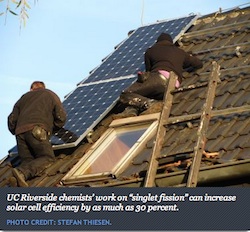A recent article published in the Journal of Physical Chemistry Letters by University of California, Riverside (UCR) chemists looks at the research focused on “singlet fission,” a process in which a single photon generates a pair of excited states. This 1->2 conversion process has the potential to boost solar cell efficiency as much as 30 percent.
 In addition to improving solar panels, the research can also aid in developing more energy-efficient lighting and photodetectors with 200 percent efficiency that can be used for night vision. Biology may use singlet fission to deal with high-energy solar photons without generating excess heat, as a protective mechanism.
In addition to improving solar panels, the research can also aid in developing more energy-efficient lighting and photodetectors with 200 percent efficiency that can be used for night vision. Biology may use singlet fission to deal with high-energy solar photons without generating excess heat, as a protective mechanism.
Today solar cells work by absorbing a photon, which generates an exciton, which subsequently separates into an electron-hole pair. It is these electrons that become solar electricity. The efficiency of these solar cells is limited to about 32 percent; however, by what is called the “Shockley-Queisser Limit”. Future solar cells, also known as “Third Generation” solar cells, will have to surpass this limit while remaining inexpensive, requiring the use of new physical processes. Singlet fission is an example of such a process.
“Our research got its launch about ten years ago when we started thinking about solar energy and what new types of photophysics this might require,” said Christopher Bardeen, a professor of chemistry, whose lab led the research. “Global warming concerns and energy security have made solar energy conversion an important subject from society’s point-of-view. More efficient solar cells would lead to wider use of this clean energy source.”

